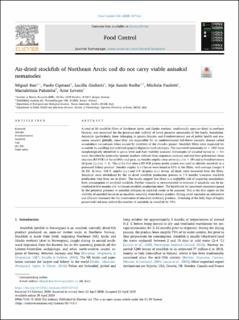| dc.description.abstract | A total of 80 stockfish fillets of Northeast Arctic cod (Gadus morhua), traditionally open-air-dried in northern Norway, was examined for the presence and viability of larval parasitic nematodes of the family Anisakidae. Anisakids (particularly those belonging to genera Anisakis and Pseudoterranova) are of public health and economic concern globally, since they are responsible for an underestimated fish-borne zoonotic disease called anisakidosis (anisakiasis when caused by members of the Anisakis genus). Stockfish fillets were inspected for anisakids by candling and artificial (pepsin) digestion methodologies. The recovered nematodes (n = 342) were morphologically identified to genus level and their viability assessed. Subsamples of anisakid larvae (n = 31) were identified by molecular/genetic markers inferred from sequences analyses and real time polymerase chain reaction (RT-PCR) of the mtDNA cox2 gene, as Anisakis simplex sensu stricto (s.s.) (n = 29) and as Pseudoterranova decipiens (s.s.) (n = 2). This is the first time a RT-PCR primer/probe system was used to identify anisakids in a processed fishery product. Anisakis simplex (s.s.) larvae were found in 81% of the fillets, with average (range) 4 (0–35). In total, 338 A. simplex (s.s.) and 4 P. decipiens (s.s.) larvae, all dead, were recovered from the fillets. Anisakids were devitalised by the air-dried stockfish production process in 7.5 months (common stockfish production time from sea to plate). The results suggest that there is a negligible risk of acquiring anisakidosis from consumption of air-dried stockfish. Further research is recommended to evaluate if anisakids can be devitalised in five months (i.e. minimum stockfish production time). The health risk for sensitized consumers posed by the potential presence of anisakid allergens in stockfish needs to be assessed. This is the first report on the viability of anisakid larvae in an unsalted, naturally dried fishery product. Drying could represent an alternative and efficient treatment for the inactivation of anisakids in fishery products. Trimming of the belly flaps of highly parasitized cod may reduce the number of anisakids in stockfish by 74%. | en_US |
